 | HoplandDartmouth's Bustling SoWhee District | |||||||||
|
01.29.2005 Update:
This page reformatted slightly. 11.04.2003 Update:
05.04.2003 Update:
Lo-Yi Chan's master plan for the College (2000), described by The Dartmouth, also proposes a bar building east of the Hopkins Center on Lebanon Street as this detail indicates: 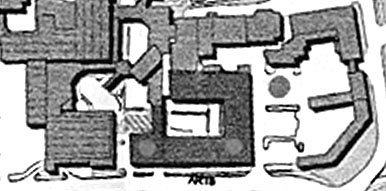 03.18.2002 Update:
Image showing footprint of the Hop overlaid on earlier buildings added. 11.21.2000 Update:
| |||||||||
1 Hopkins Center Vertical File, Special Collections, Dartmouth College Library. 2 Stewart Brand, How Buildings Learn (New York: Viking, 1994). |
Egotism: At the dedication of Spaulding Auditorium, architect Wallace Harrison said a building is either clean and straightforward or it is a mess. This building will never have any conspicuous marks like pimples on the outside because it is a clean building. Thank you."1 Real buildings, however, change. Such change is natural and not to be avoided; in fact change happens precisely because it makes better buildings.2 The idea that the designer is omnipotent and should be expected to imagine an entire complex of buildings, to be used over several lifetimes, is simply foolish. So difficulties in the use of a building are not necessarily the fault of bad design, but the fault of our expectation of perfect design when we have no reason to expect it. This being the case, we can say that the Hop is not even straightforward. Designing a building so that it is unreceptive to change and addition, a particular problem of Modernist architecture, whether it be in materials systems, trim, or the idea that the building is an island, is bad design. The idea of a total building as masterpiece not to be tampered with, while often encouraged by the architect, can doom users to living with the inevitable mistakes rather than fixing them. (Perhaps the problem, then, is not bad design so much as forcing users to live with bad design...) Having made excuses for the architect's ego, I must point out that one should not be able to make a semi-functional door handle: | |||||||||
|
Bad Design: Can I be the only one who makes this mistake in the Hop? When opening the door to the basement stairs above Paddock, I always give the door a good tug. And then I find that one is supposed to push. Why does this happen every time? Rather than fault the intelligence of the people who use the door, I prefer to blame those who designed it. After all, the proper door handle, as one of the most ancient, basic, and intuitive pieces of furniture, should require no thought to use and is a poor piece of work if it does. This particular door-pull, and I call it a pull, is an elegant work of bent and polished brass plate, with what must be twenty-four inches of lovely gripping edge around three sides. This shape does nothing if not invite a good pull, even though this door is made for pushing. In fact, the only difference between this handle and the other standard Hop handle, the one that is actually meant to be pulled, is that the latter has even more pulling edge, its center being open rather than solid. Surely this minor difference is not some sort of obscure symbology we are supposed to recall each time we use the door? Should proper use of such an intuitive product as a door handle require the learning of unique icons? If so, why can other doors get away without symbols, the side door of Hitchcock being one example? True, this particular Hop handle confuses us by its unique avoidance of the standard "Push" legend that similar Hop doors bear. But this discovery begs the question of whether any door should need an inscription. A handle incapable of communicating its "pushability" simply through its form is poor design at the most fundamental level. But the door handle is merely the tip of the anti-intuitive iceberg that is Dartmouth's Kulturpalast. Of the three main entrances, the grand one leads to a little-used theater, the hidden one leads to the crucial and high-traffic mailboxes and the heart of the complex, and the back door (why a building with two faces should have a blank, anonymous back at all is beyond me) is hidden behind a screen of stone despite its function as the major entrance for townspeople attending frequent events in Spaulding. Anyone not in an airplane cannot visually "read" this all-at-once megaplex (for that is what it is, rather than the collection of typologically separable buildings it should be), and therefore neither can most people use their intuition to navigate it. As a comparison, how difficult is it to tell where one should enter Baker, or what its major and minor components are, the fact that Carpenter and Sanborn must house different functions, just from looking at it? The different functions of the library are not hidden away in some basement known only to the initiated. Even Baker's basement is easy to find by the major staircases at the building's poles, as contrasted with the window-cum-door by the phone booth that one must find to reach the bowels of the Hop. Never mind the dim and little-known exit-only stair that communicates between that obscure corridor past Paddock (people work down there!) and the funny protrusion (pimple?) bearing the Bicentennial plaque that is too far away to read in the Zahm Garden. I went years needing that stair before I found it, and I have met several people who still recall the day they discovered it. Though everyone can describe one part of the Hop's north elevation, the iconic demi-vaulted facade, the Hop as a "building" is amorphous and unnamable. One might ask, for example, if the building even has sides. The Hop is really a collection of buildings attempting to be single entity, and sacrificing the possibility of legibility in the attempt. The lack of a major corridor leading from one main place to any other in the Hop is an obstacle to a visitor's finding anything by intuition. Yet this is how humans navigate in the world. If you are standing in the cafe and do not know the Hop, where would you guess the exit to the Green is? Where is a major auditorium, or a minor theater? Perhaps there is something outside in the "courtyard"... Is it a courtyard at all, since one cannot walk in it or see people traveling through it, hidden away as they are at the sides instead of signaling by their tread the useful but chained-off navigation route right down the center? The stopgap measure of installing signage in the hop is one solution to the problem of navigation, but the question "how do I get out of here?" is still heard often. And most visitors do not even venture into the basement. | |||||||||
|
Destruction: The term "destruction" is not normally associated with the Hop. But a glance at the building's south facade can bring that word to mind. The architects had great contempt for the street and the town, or at least their design communicates a great contempt. The wall and parking lots lack a human scale, a rhythm of openings and entrances, a continuous street front, or any recognition that the context is a street of small house-shops. In fact, the builders of the Hop were determined to start with a blank slate, whether they used it all or not, and demolished eleven mostly nineteenth-century buildings, including an 1867 brick gymnasium. Pleasant or humanizing features along the street are surely not too much to ask, especially as the building takes the trouble to force the Music Department to burrow into the earth so the building can present a mere one- or two-story profile. This land is valuable and lies in a district of three- and four-story buildings and business blocks, but does this matter to the Hop? Might the designers have given the offices space above ground with views that encompass an interesting street rather than a lightwell? Not only did the Hop kill Lebanon street, it even gave up an opportunity to rent out a row of shops and thereby make some money for the College. The parking lots as well could be placed behind one range of the building, or at least behind a wall, to keep them from creating a vast hole in the street.
| |||||||||
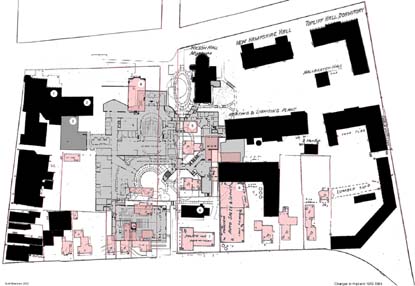
Map Showing Footprint of the Hop [click to enlarge] | ||||||||||
|
The north facade, while not as destructive as the south, has similar problems. The partial abdication of the responsibility to enclose or define the street at the front of the building becomes quite apparent as one walks down the steps to the HBs, passing the absolute front of the Inn on the right side while the vague gardens and protruding lumps of the building pass by on the left. The one recognizable front to the building seems like a main entrance but leads to the Moore Theater ("aha, this side passage may go somewhere!" one is forced to think, once there). Instead of continuing the line established between this grand entrance and the Hanover Inn, the rest of the building sits far back from the street, hidden behind a sunken garden and clumps of trees. This is entirely different from Baker sitting back behind its lawn: the sunken garden is not the quadrangle that it replaced, but a crowded through-way blocked by walls, chains, stairs, changes in level, and a fountain. This type of contemplative garden is sorely needed at Dartmouth, but not on top of a massive traffic route. But not all is bad; the Hop can be improved, its useful characteristics taken better advantage of, and its best parts enhanced. | ||||||||||
|
Possibility: Hopland:
Dartmouth's Bustling SoWhee District: The arts need to expand, with the Studio Art department gaining strength and prestige and the number of majors and minors growing tremendously in recent years. Dartmouth's Faculty Studios and the Pottery Studio, both functions that should be in the arts area, are presently located out of town in Lebanon and Lewiston (Norwich). The Hop may have its problems, but since it is here and is not going anywhere, why not make the best of it? After writing this I found Robert Campbell's 1986 review of the Hood which describes the museum as "a building so ungraspable you could spend your whole four years trying to figure it out and not succeed" (he says that students "yearn to achieve a sense of belonging by becoming the inside-dopesters of their environments, the initiates who know where all the secret places are"). He also describes the Hop as "sharing with the Hood one quality, which is explorability." This is a positive twist on the confusion of the place, but it might as well be capitalized upon.
| |||||||||
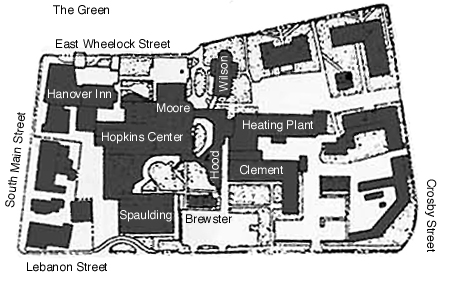
Map of Hopland | ||||||||||
|
A. Character: The "arts end" of the campus is composed of the Hop, the Hood, Wilson, Clement, and the Heating Plant and its additions. We can see this precinct as a sort of architectural playground, palimpsest, or collage. | ||||||||||
3 Douglas Brenner, "In Retrospect: The Hood Museum of Art, Dartmouth College," Architectural Record 174, no. 2 (February 1986), 108-119. |
This growing concretion is informed by
The best thing about Hopland is that it is not too nice to change -- it reflects its current use, it is adapted to circumstance. The name "Clement" shifts from one building to another, a staircase shuffles to the west in the entrance to the Moore Theater, part of the Hop is chopped off to connect to the Hood, the snack bar is moved and becomes the Courtyard Cafe. Being a non-revered landmark and adapting to a growing demand for the arts allows and forces Hopland to be anything but static. The Hop's already rambling nature can be emphasized, as the Hood has begun to do, and it can become even more a picturesque castle, a haunt, a place whose passages and crannies and shortcuts are to be learned by students, a place whose original appearance is recognizable only by the front entrance left unobscured. Brenner writes that:
Dartmouth needs a well-enclosed space, and this part of the campus is an antidote to the more uniform, rigorous and planned Beaux-Arts parts -- it has a more organic attitude. An architect here is freer. Hopland appears as passageways in a fabric of buildings rather than buildings with spaces between, where the courtyards are figures on a ground rather than the opposite. It is a rambling piecemeal contrast to the rest of campus, a haven for picturesque disorder and industrial stylings against the rectilinear neo-Georgian village to the north. | |||||||||
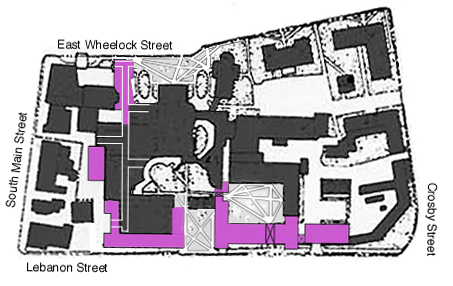
Map of Hopland showing proposed changes including altered Hop main corridor | ||||||||||
|
B. Features: The Street: Wheelock Street should be narrowed to allow only parallel parking on both sides and, along with the normal corner crossing, it should have sidewalk-grade crosswalks connecting the Collis Passage to the Hop and the Hop to the Reed corner. These allow pedestrians to stay on a sidewalk while requiring autos to go over a gradual bump, an architectural expression of the pedestrian's right-of-way that recasts today's contradictory pavement into a proper relation to the law. If planners are enthusiastic about returning the street to people, they will return this street to its L-corner shape. This would return part of the street to the Green from which it was carved in the 19th century. (Drivers once made a left turn in front of Wilson and then a jog to the right down East Wheelock.) Of course, this is far too radical for people who use the town not as a place but as a route (i.e. most drivers) and few but the Dutch or the Swedes prefer streets that are made intentionally difficult. The Smokestack: This becomes a sign for the College or the arts, perhaps like the Wren monument in London, which is topped only by a conveniently non-figurative gold bauble. For a bit more historical reference, the smokestack could develop closer to Nelson's Column in Trafalgar Square, with a statue above (call it Webster's Column, or the Grinch's, or Wheelock's). Or preserve it as an unabashedly industrial landmark, like the Shot Tower in Baltimore. Because of its lowered height, the column will be just visible over Wilson from the center of the Green, say, as a focal point on its NW-SE axis. | ||||||||||
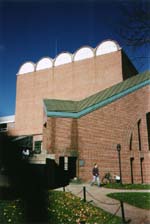 |
An Advertisement: A great advertisement (for Dartmouth? Eat at the Hop! The Arts! Carnival, Now Extra-Crispy! Try The Drama Department Today! Shakespeare -- Looks Yellow, Tastes Green!) to be painted on the great blank wall overlooking the Hop Courtyard, perhaps by an artist-in-residence as the Hop's counterpart to the Orozco Frescos. Let it fade and become a ghost sign overgrown with ivy. From Lebanon Street it will be partially and interestingly obscured by the jutting, angling covered staircase of the Hood. Some Infill on Wheelock Street: Give the Hop a context on the west side -- it is no longer an island and can no longer afford to be one. The Hop has already been infilled to the left, now the right needs the same treatment. Extend the facade of the Inn to meet the Hop (speaking in terms of massing only), or even build an addition atop the Zahm Garden that extends to the street as the Inn does, mirroring Baker's arms. This new building could use an interior groin-vaulting system that adopted the scale of the demivaults of the Hop facade. Though an arm reaching all the way to the street might seem to try to upstage the Hop, we should recall that the similar Lincoln Center is in fact quite attractive when seen down the narrow view defined by its forecourt buildings. The name over the door to this new main entrance should by rights be the one to read "Hopkins Center." What has become the iconic Hop facade, the main entrance next door, would get the name of "Moore Theater," which is what it really is anyway. Most importantly, the doors of this new entrance to the Hop will connect directly to the main corridor of the Hop in a straight shot through the Jaffe-Friede Gallery. This will be a grand entrance with a lobby and hallway made elaborate enough to signify its importance as the main axis of the arts complex. John Regan, then a second-year architecture student in Robert A.M. Stern's studio at Columbia, turns out to have proposed a straight corridor and new entrance on Wheelock Street along these lines in 1981, and it appears in Precis 3 (1981), 82-83. Though keeping the HBs where they are is an idealistic gesture toward historical continuity and the involvement of all in the arts, the boxes might be moved to an expanded student center elsewhere unless the Wheelock Street crossing can be made less disruptive as mentioned above. Forcing pedestrians to cross several lanes of impatient traffic every day just to get their mail is a dangerous absurdity. Various arts uses can move into the HBs and Alumni Hall. Alumni Hall is given a refined replacement. How were the designers imagining this place would look? Studios are one thing, but the gathering-place that one can expect to be the most conservatively-decorated on campus should not be a characterless factory floor. The addition of wall hangings and plaques livens things up a bit, but they are obviously an attempt to make the best out of the wrong room. After all, even if form is to follow function, one of the functions of the hall must be to inspire nostalgia in the classes of bygone days. But designers should not abandon the hall and start over again somewhere else. That is the mistake they made in tearing down Bissell Hall on this site, which would have made a superb Alumni Hall. Besides, the current room is now 35 years old and has built up some associations. Take it and work with it, get a creative architect to dignify it, perhaps treating it as a great barrel-vaulted hall lined on one side with great windows rather than the glass wall that is there now. Monumentalize the entrance stair as befits an approach to such a hall and bring it in straight where the fountain is now, with a closer connection to the Inn. | |||||||||
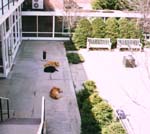 |
Infilling the Zahm Garden and getting rid of the tiny HB entrance and its little back-door-feeling staircase is not too radical. Charles Moore proposed such a thing for a version of the Hood that flanked the Hop on both sides. The bluestone paving should be grassed over as much as possible and replaced with something suitable -- those slabs do not work in New Hampshire and were never meant to. All this happens in conjunction with refacing of Inn for interest and variety, as in the visual-bulk-reducing proposed by Grace Kim '97. Some Infill on Lebanon Street: The identities of all parts of the complex should be made more separate and identifiable from the outside, with Spaulding being made to seem a connected building rather than a room inside a building. Signage, paint and especially remodeling of entrances and hallways can accomplish this. Spaulding's outside entrance can, for example, be made appropriately significant and read "SPAULDING" over the door. This will give townspeople who arrive for a show the feeling that they are actually entering the theater and are welcome there. | |||||||||
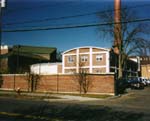 |
A new south range of buildings could be built south of Clement to enclose a courtyard. The arm could even return to frame Brewster between this new wing and the rear of Spaulding. Old College Street will still allow for trucks. This range will also define, repair, enliven and enclose Lebanon Street, possibly even extending beyond Clement to the east if it needs to. While the top floor of this Lebanon Street range contains studios and classrooms, the bottom floor can contain a row of shops to bring variety and life to the street as well as income to the College. | |||||||||
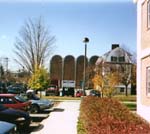 |
A companion bar-building would extend west and then north to mercifully cover the back of Spaulding and define the space behind the bank. Some say that the rear of the Hop should honestly reflect its use as a loading zone, but there is no reason to flaunt it at the expense of the street, and the loading function will still be visible at the HBs' back door where it is actually needed. Blocks have insides and outsides, not fronts and backs. By turning the corner to the north and continuing up the west side of the Hop, these shops can help define the space recently prettified by the Town in front of J.B. Jammin'. Access will of course be preserved for service and delivery vehicles, and perhaps a parking garage could be placed there as well (it is a sloping site and the current lightwell vividly demonstrates this possibility). The shacks behind Lou's can be redeveloped into shops. Though there will not be space for a Grand Union, such stores as Bean's, The Hanover Cobbler and the shops in Old Nugget Alley would do well here, especially as this area is not in the Hanover Zone of Death as defined by Geographer Peter Jolicoeur '95 (with the Galleria being in that Zone). Also Expansion into Existing Buildings: I hope the arts can someday expand into the wonderful Heating Plant building, which could prove amenable to such adaptation with a long monitor roof, especially since it already adjoins the Hood Museum and Clement Hall. A Folly: A small tower, pyramid, obelisk or other monument or memorial, a formal counterpoint to the Stadium, can be built on the corner across from the Stadium to signal an entrance to Lebanon Street from the east. Somewhere near this corner the Richard Nelville Hall monument in Baker once stood. Without resorting to the straightforwardness of a gateway or sign while still including the most possible interest, a monument will let people know that they are entering someplace particular, especially when Webster's Column becomes visible behind it.
C. Conclusion: Much of this development will indeed happen, because it is inevitable for the growing College to use the valuable space so close to the Green and the central business district. Rumors of plans for a new studio/shops building south of Clement, for example, are in the air, and we can assume that Charles Moore will have been just the first to suggest building in the space between the Hopkins Center and the Inn. It merely seems strange that the builders of the Hop did not take better advantage of their site but left it for the generation of forty years later. | |||||||||
| Top | ||||||||||
| ©1995-2005 Scott Meacham
This page URL: www.dartmo.com/hopland/index.html dartmo@gmail.com | ||||||||||